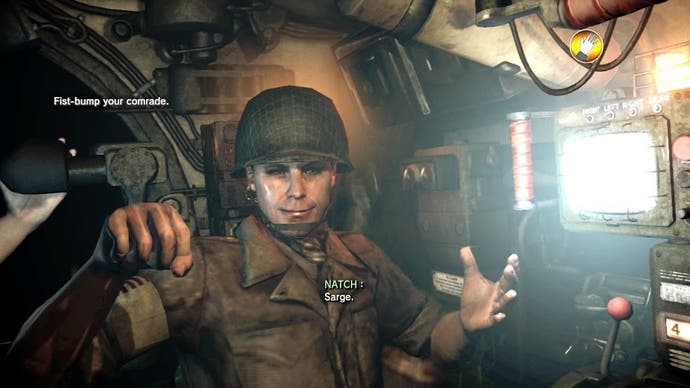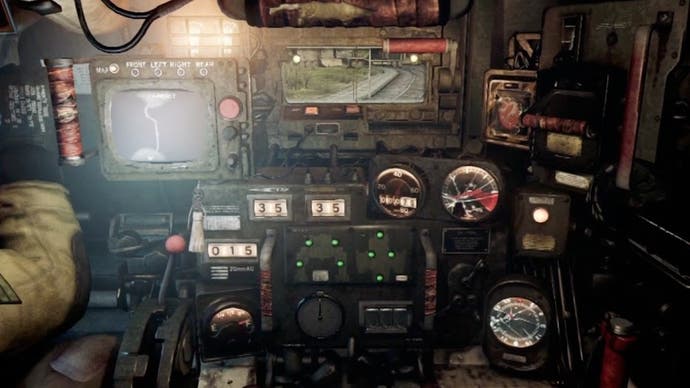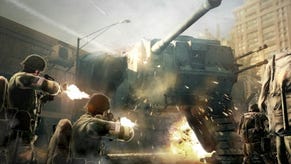Why From Software's worst game is worth learning from
And how Steel Battalion was the ultimate Kinect game, for better and for worse.
Heavy Armor might be the perfect Kinect game, or at least, the most honest, because it reveals how interesting life can be when technology gets in your way. Green-lighted way back when Kinect was known as Project Natal, the game posits a near-future in which a silicon-guzzling microbe has devoured every computer on the planet, setting back the science of combat to roundabouts the close of the first world war. Deprived of GPS, drones and other decadent trappings of 21st century warfare, the Earth's nations are obliged to duke it out in gas-powered mechs or "vertical tanks" that handle as elegantly as elephants in high heels.
The practical consequence for the player is that mechanics and features we take for granted, such as scanning a minimap, are either absent or an absolute bloody chore, as you poke at crackly CRT displays, crank handles and generally do your best not to fall flat on your front bumper. It's a suspiciously ironic choice of supporting fiction for a Kinect title - joined at the hip to a peripheral that was billed as a revolution in how games are played, but which has, by and large, just made games much harder to enjoy.

There's only so much credit you can give From Software's writers on this count, however. Heavy Armor was conceived alongside the original and more expensive version of Kinect, which sported a standalone processor, so labelling its unwieldiness a cheeky commentary on Kinect's impotence is a step too far - the plain truth is that it was developed to run using a more capable device. But that premise remains a charming, playful response to what's supposedly a problem of technology, and if Heavy Armor is a failure in many other respects, it's a courageous one. At a time when most other Kinect developers were quietly introducing controller support, or divesting their work of challenge to make up for recognition issues, only From Software could have put together a game in which you fight the controls as ferociously as you do your enemy.
Forget jet-dashing through clouds of neon detritus, painting targets with a cluster laser and other traditional mech pastimes. In Heavy Armor, putting the engine into gear is a feat worthy of Optimus Prime. To begin with you'll need a chair that's just the right height, so that Kinect can distinguish between your arms and legs as you reach for the lever by your knee - beanbags, sofas and anything with armrests won't cut the mustard. Once in motion, your thunderous steed can be steered easily enough using the Xbox 360 controller's analogue sticks - a significant concession to user-friendliness, without which the game would probably have been unplayable. But you'll still have to worry about aiming the main cannon, which requires that you grab two handles to drag your face up to a viewing porthole, or reach up to pull down your periscope.
Both are perishable objects, as you'll learn to your cost. The periscope can be shot off, obliging you to stick your head out the hatch or peer at a crackly fold-out display if you want to check your perimeter. The porthole can be cracked or blown out completely, which clears the view but also leaves you shy of an aiming reticule and at serious risk of taking a bullet to the eye. And all this assumes that the cannon loader seated to your right is alive and in full possession of his wits, rather than a bleating mess of gore and shrapnel. What's that rattling on the hull, incidentally - rubble falling, or footsteps? Are you sure you took care of all the infantry in that foxhole earlier? Why is your co-pilot screaming all of a sudden? And why is there a grenade in your lap?
Many budding VT commanders will throw in the towel after the first proper mission, a Medal of Honor-style beach landing that pits you, fresh from the barracks, against multiple tanks and mechs supported by bunkers and protected by a minefield. But clamber over the steep entry threshold, and a workable level of functionality is achievable. Like all the better Kinect games on Xbox 360, Heavy Armor absolutely swamps the player with HUD feedback - a skeletal map in the corner of the screen, highlighted objects and text, floating icons to guide your hands. You'll never entirely grow out of the habit of slapping AI crewmates round the head while turning to look at them, or accidentally yanking the porthole shutter closed as you reach for a button, but it's usually clear what you, and Kinect, are doing wrong. Over the course of the campaign, you'll learn to control your posture and measure your gestures, holding your nerve under fire while NPCs are losing theirs. It's a bit of an ordeal and there will always be hiccups, but in the end, it's satisfying.

In the process, you'll also start to think of your mech not as a cramped and suffocating deathtrap, but as a home. There's never quite the same level of fondness players express for Mass Effect's Normandy - it's hard to love a war machine that occasionally stalls mid-firefight, and sports a top hatch you can't lock from the inside. But the cockpit is a lovely combination of steampunk eccentricity and World War naturalism, with its lurid glowing dials and worn leather grips, and while their awkward period banter can be painful (e.g. "hello podna"), your crewmates are a likeable bunch. One of my favourite moments in the game takes place in a desert, with three grunts riding shotgun on the hull, bickering about sunburn. It's a regular school outing, at least till you accelerate a bit too sharply and all your passengers fall to their deaths. Sorry Doc!
In the end, what really undermines Heavy Armor isn't Kinect but the scenario design, which almost always comes down to memorising enemy placements and tackling foes in the right order. This seems terribly at odds with the intricacy of the VT's interior, with its components (and crew) who can be individually disabled - it's almost as though you're playing one, relatively intriguing game inside a really boring one. The campaign is perhaps most engaging when it teeters in the direction of survival horror, playing on the fact that you're an ungainly, fragile juggernaut in a world of blind corners and pesky, elusive infantry. There's a mission early on when you're sent into a city at night to rescue a friendly mech, oppressively aware of how easy it would be for somebody to leap out of a second floor window and stick a knife-wielding arm through a tear in the hull.
It seems doubtful we'll see Heavy Armor's like again. Come to that, it seems doubtful at this stage that we'll see many more Kinect games full stop - Xbox One's gruntier sensor has been kicked to the curb for the sake of a price cut and graphics processing power, and Microsoft now plainly regards motion and voice control as a platform for search, social networking and video consumption, rather than brand new types of videogame. This is more than a little depressing, because Heavy Armor was, I'd argue, a genuine step forward in terms of how games are played, albeit an incredibly clumsy one. The odds are firmly against it, but a remaster could be just the thing.




